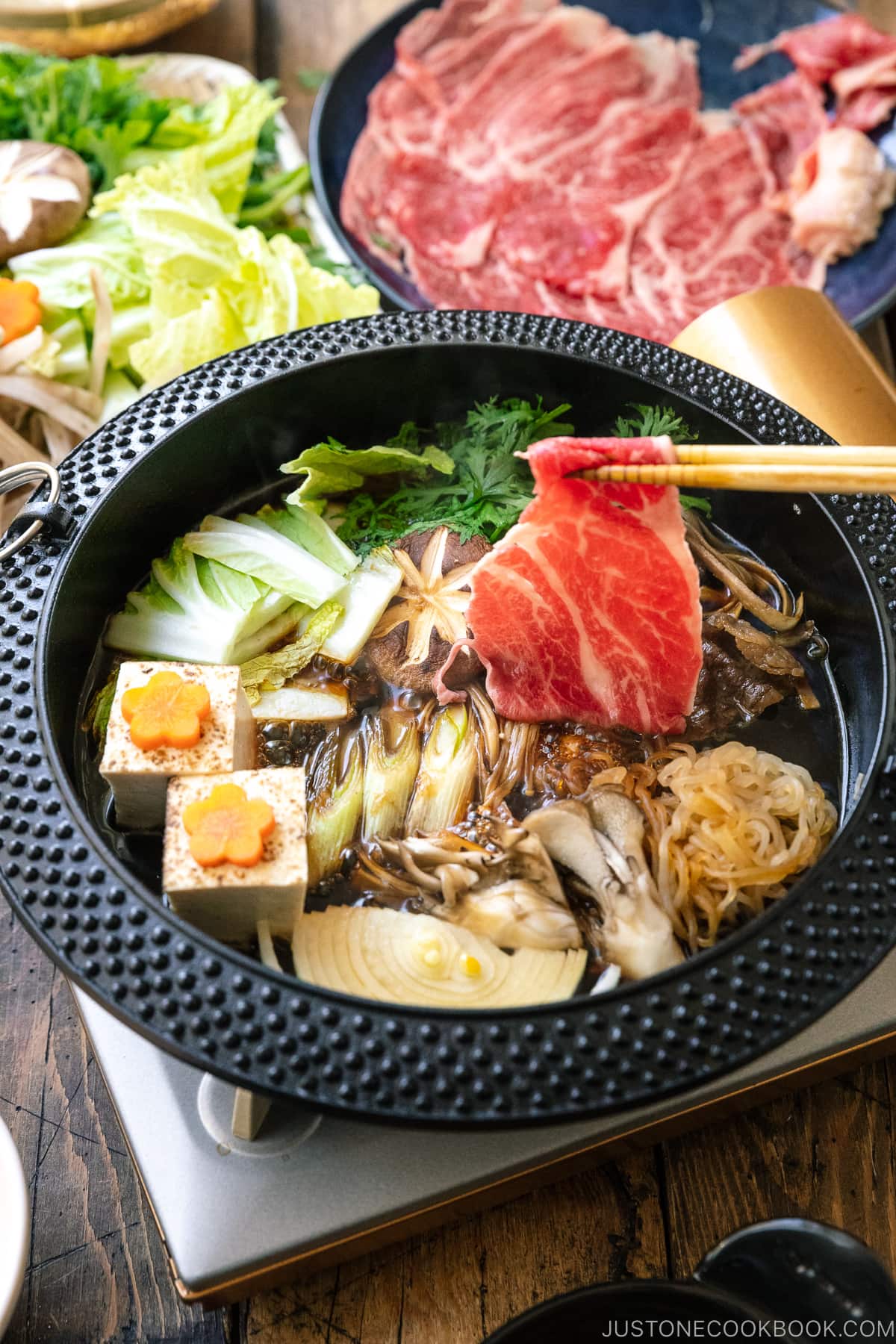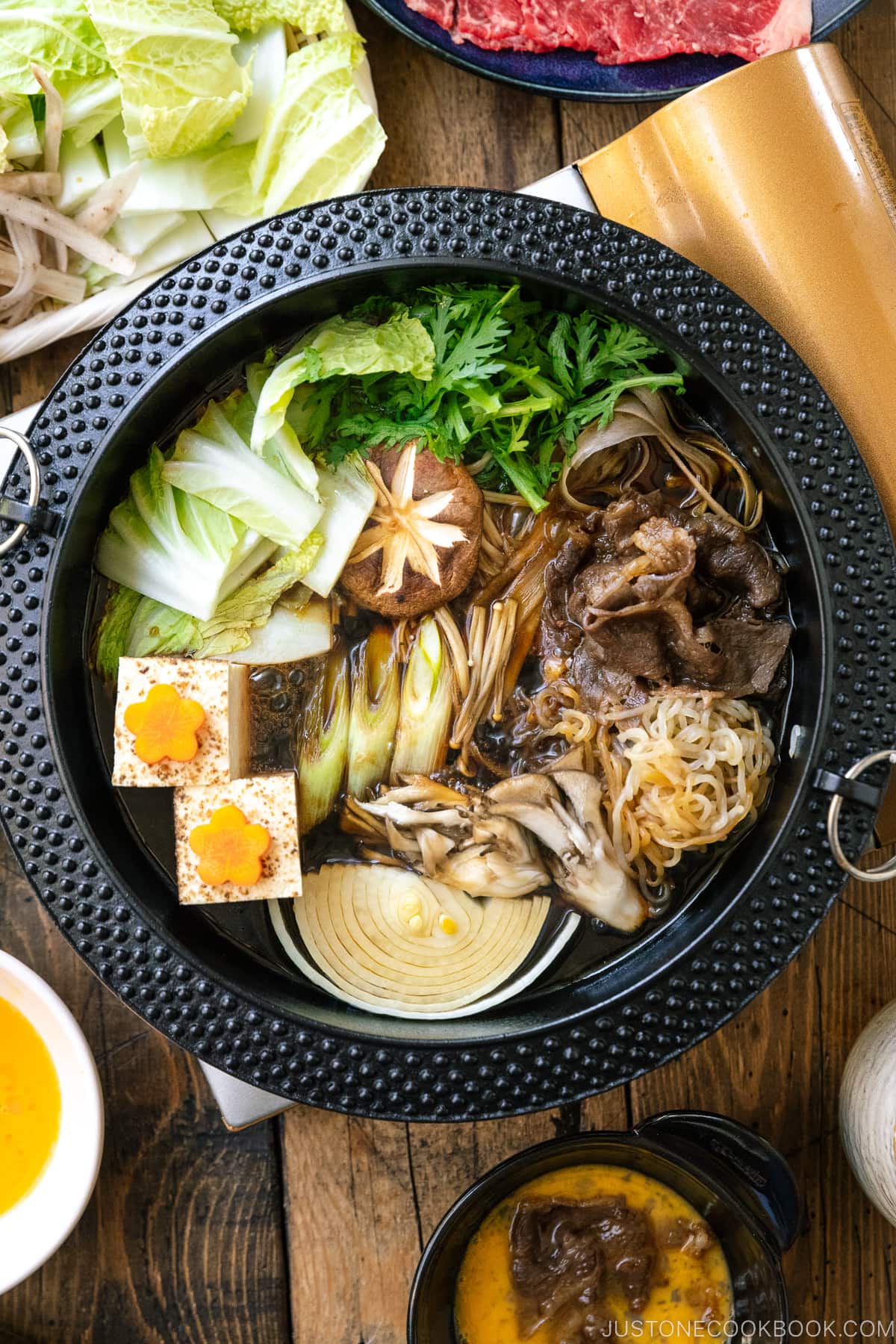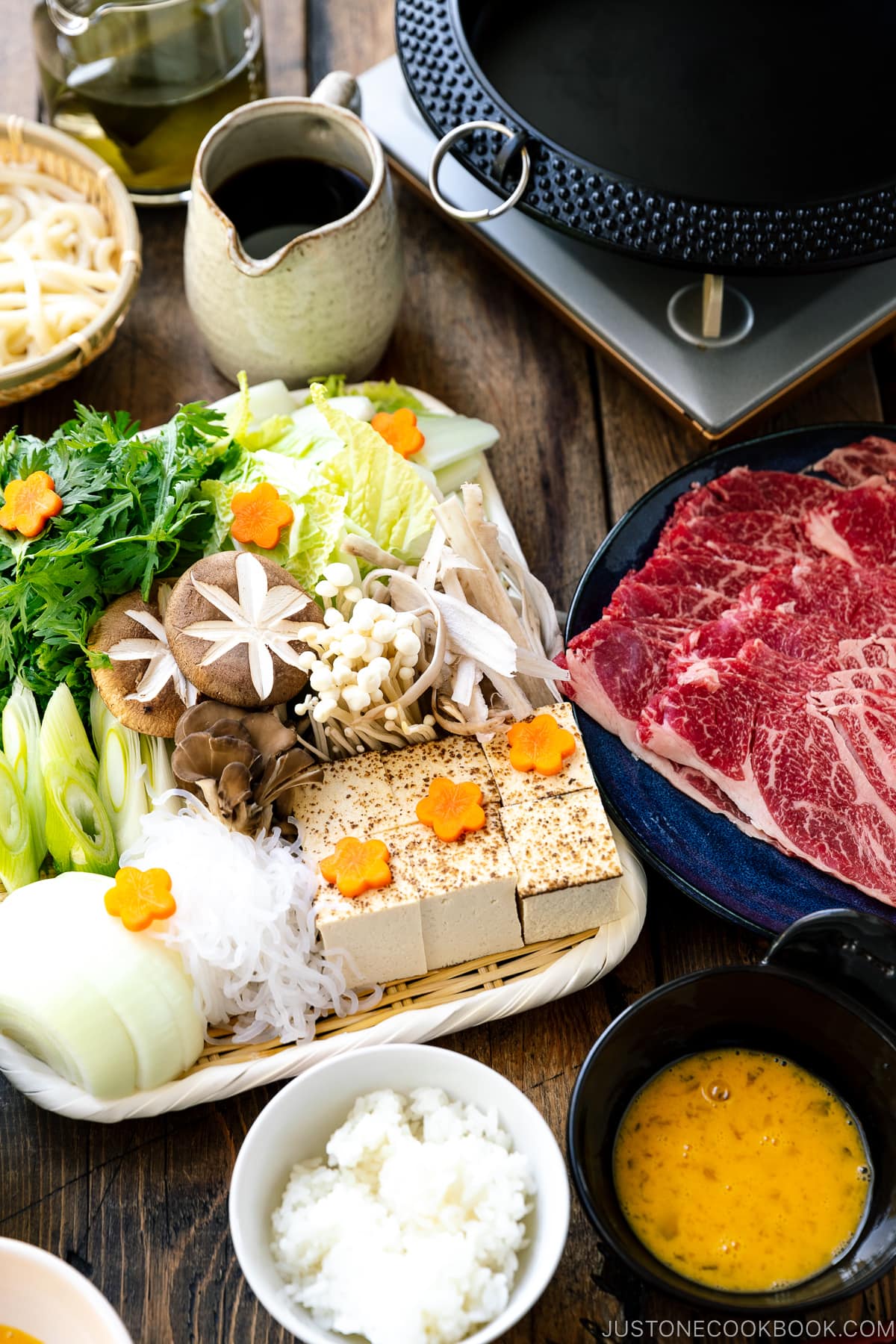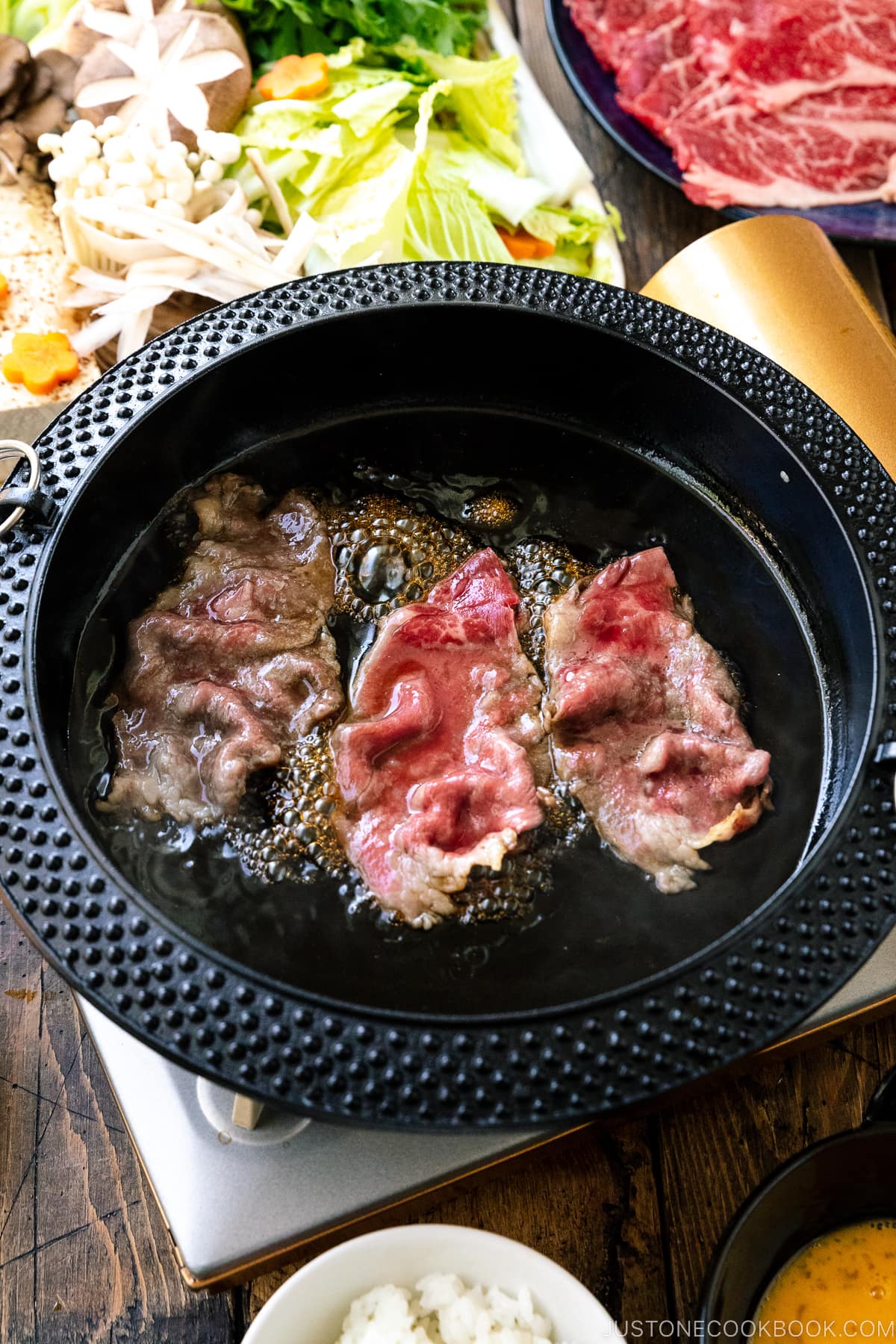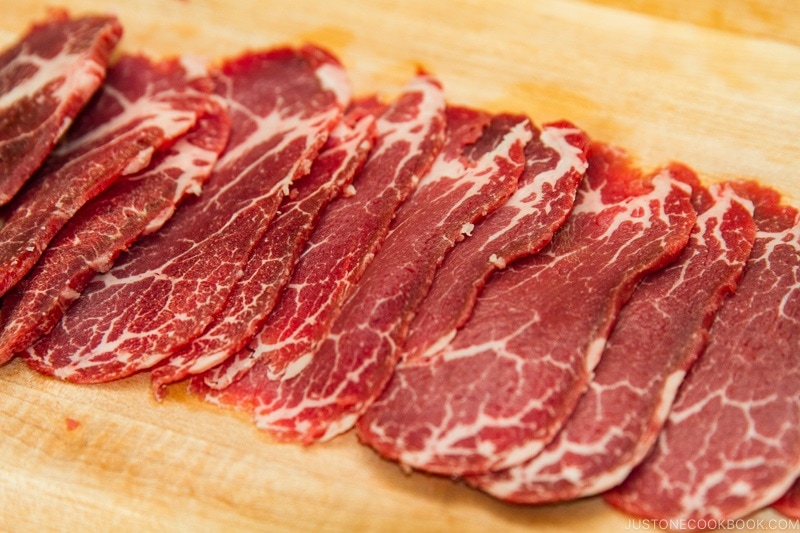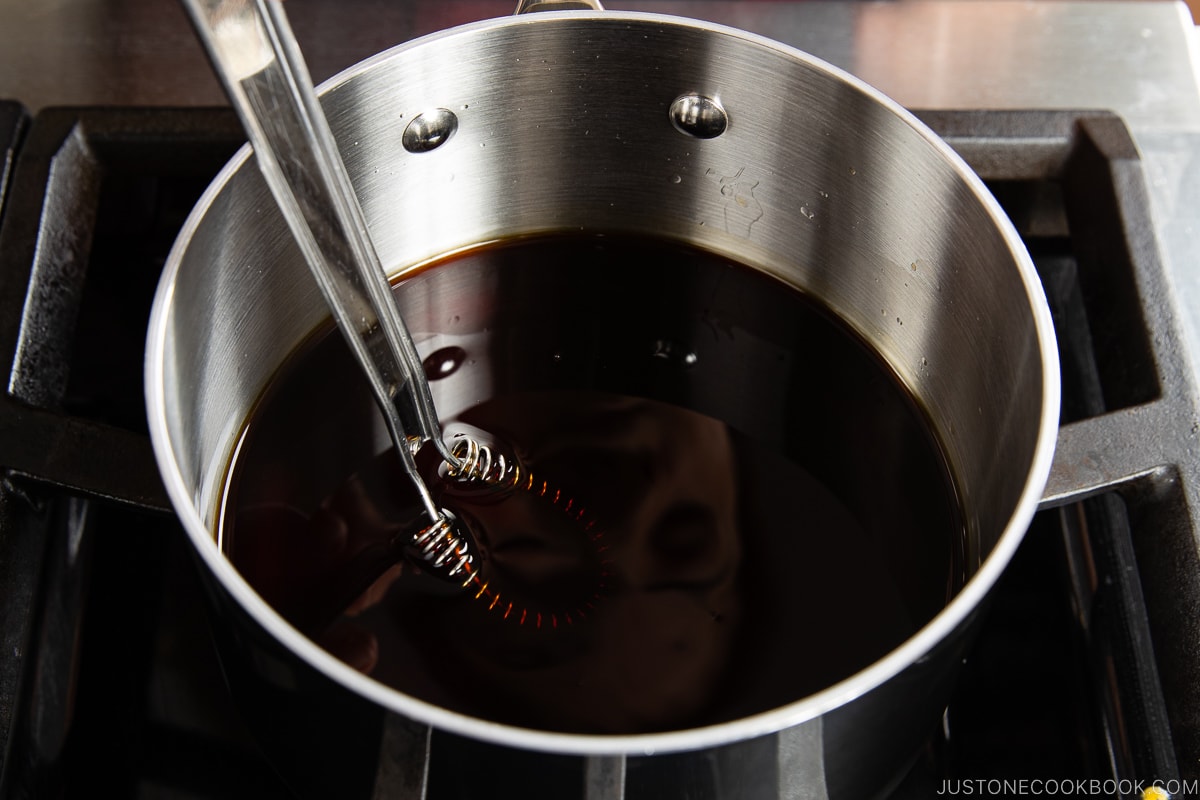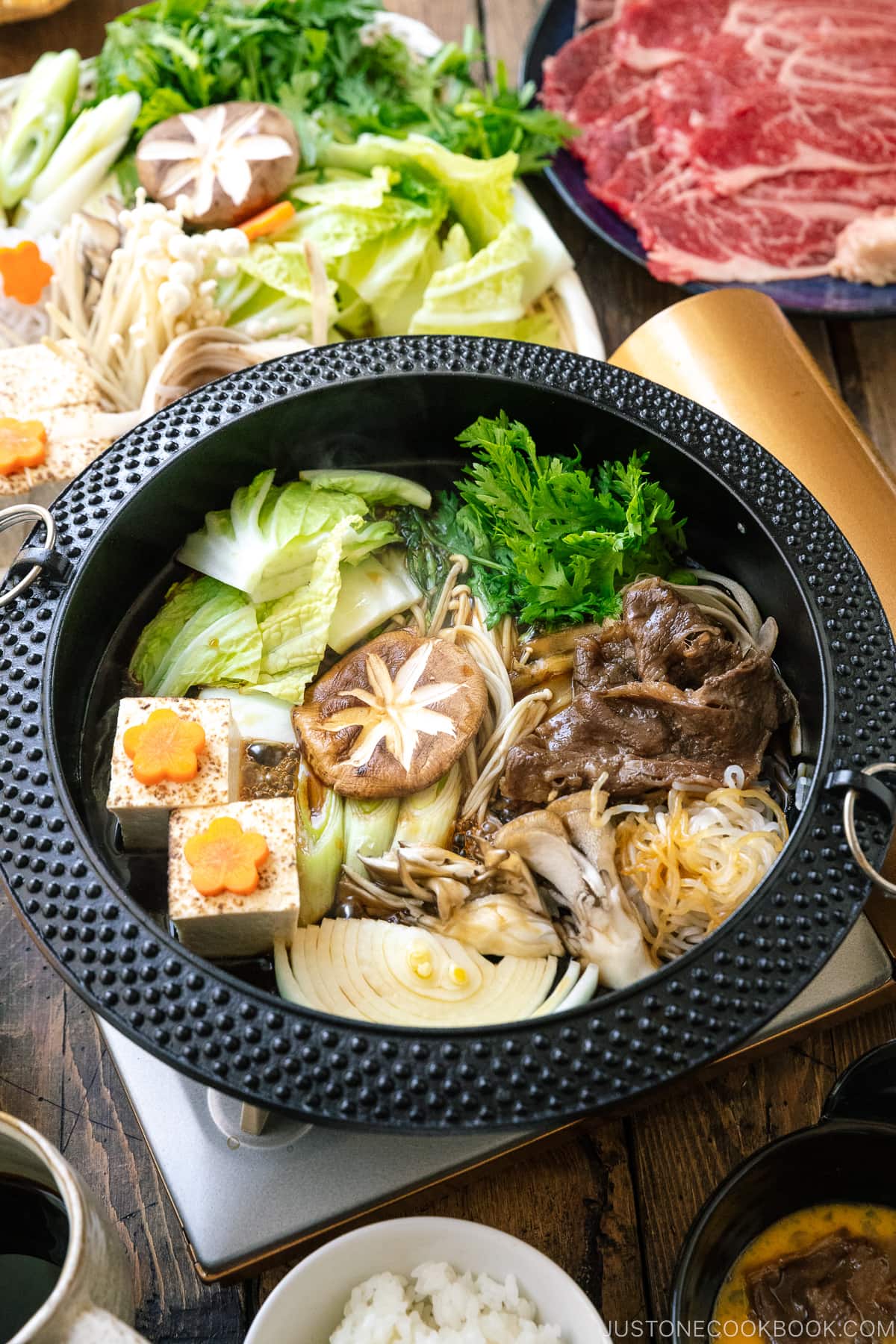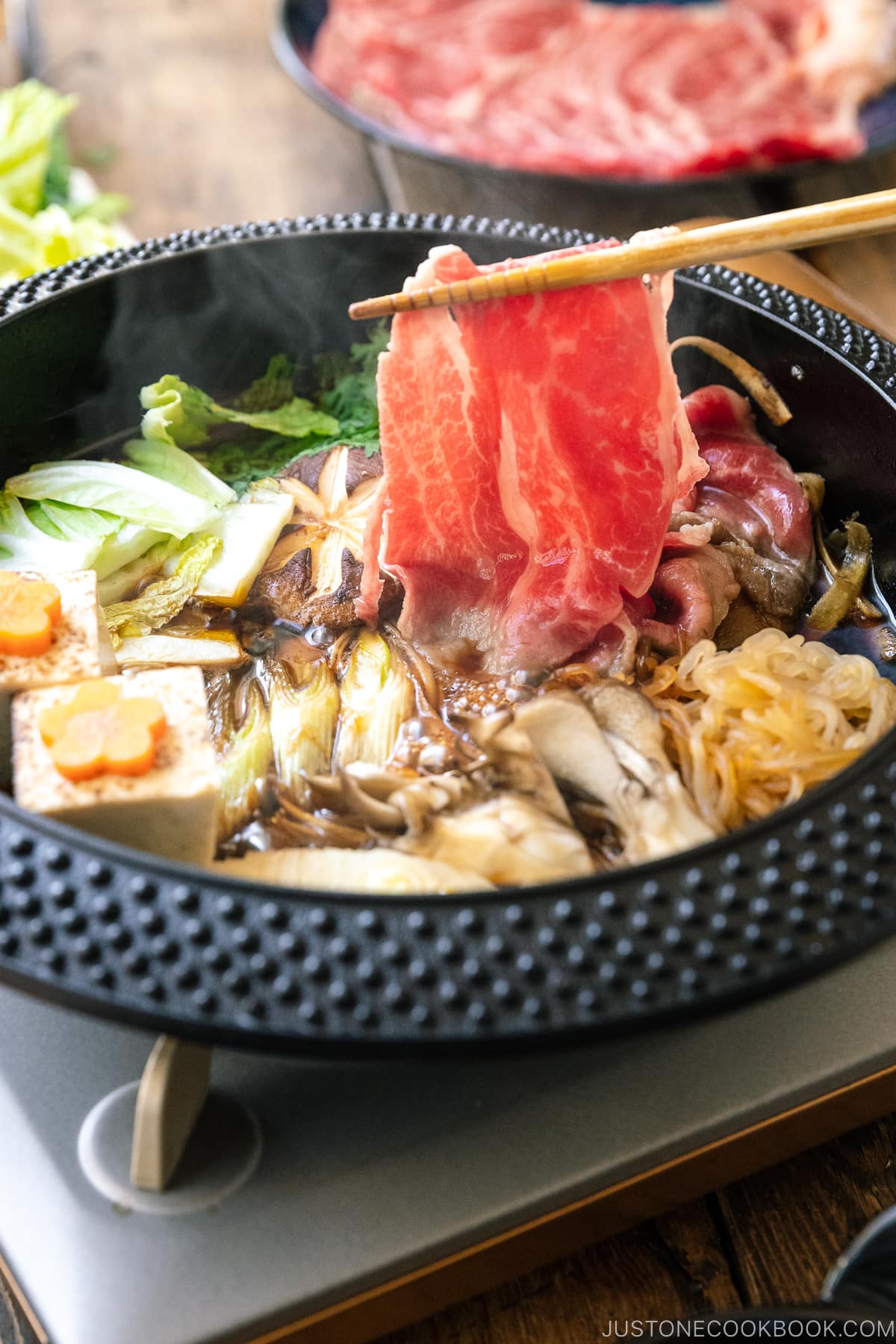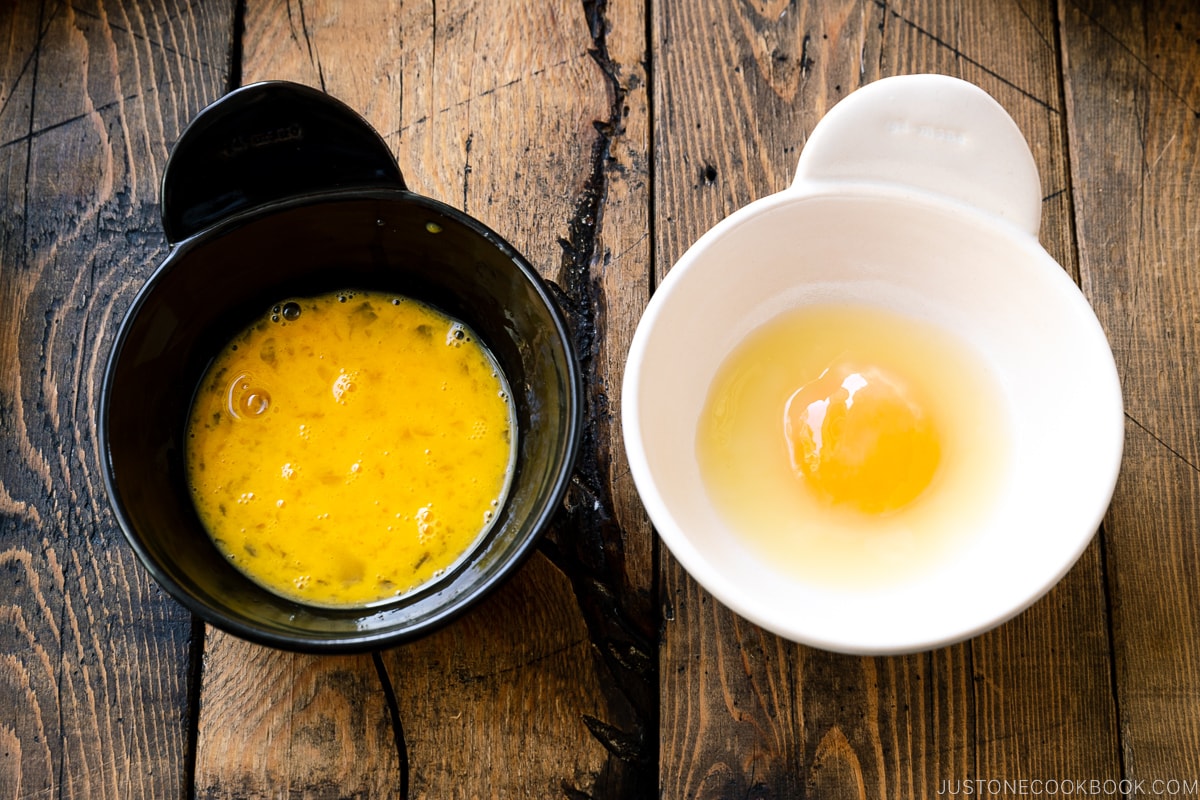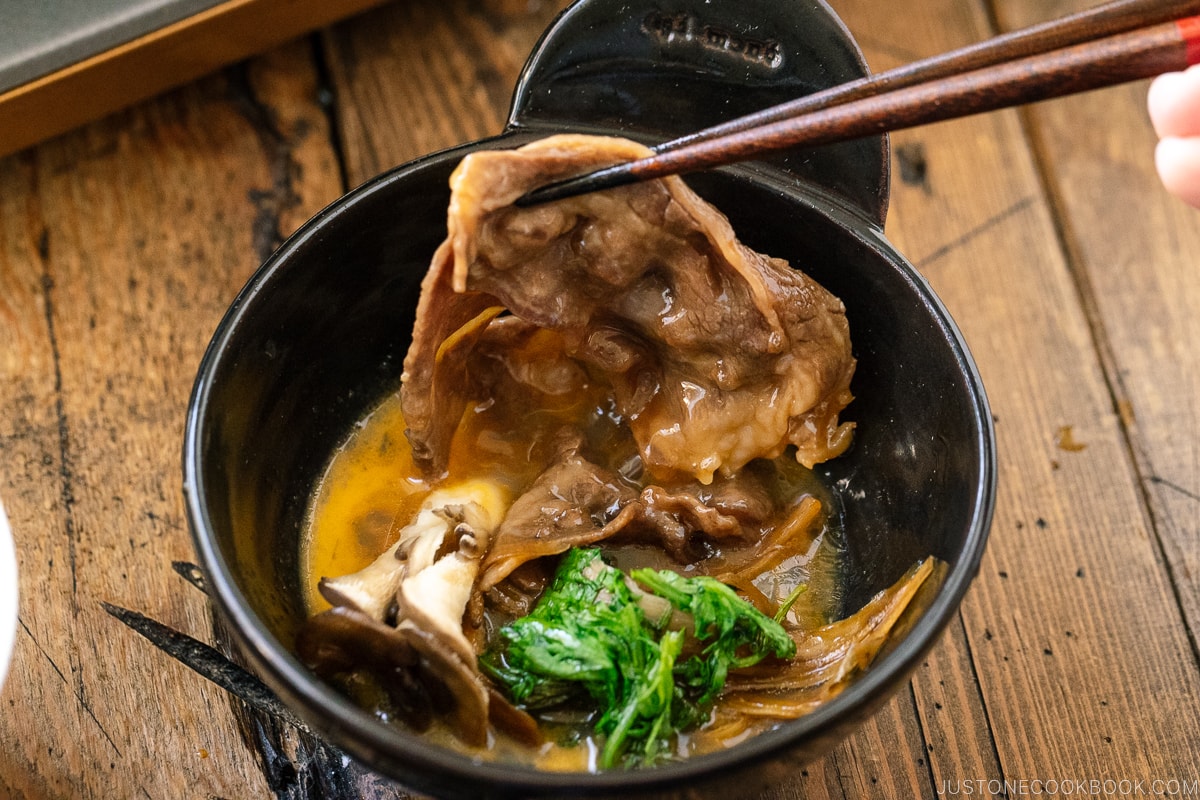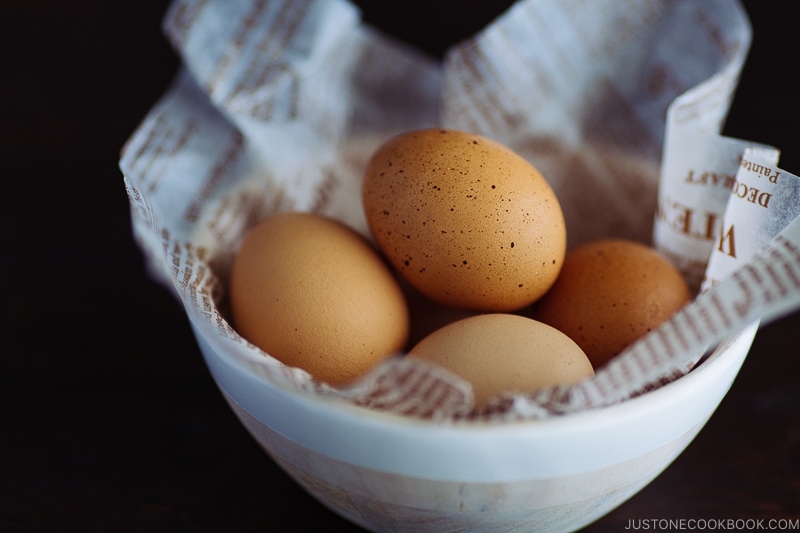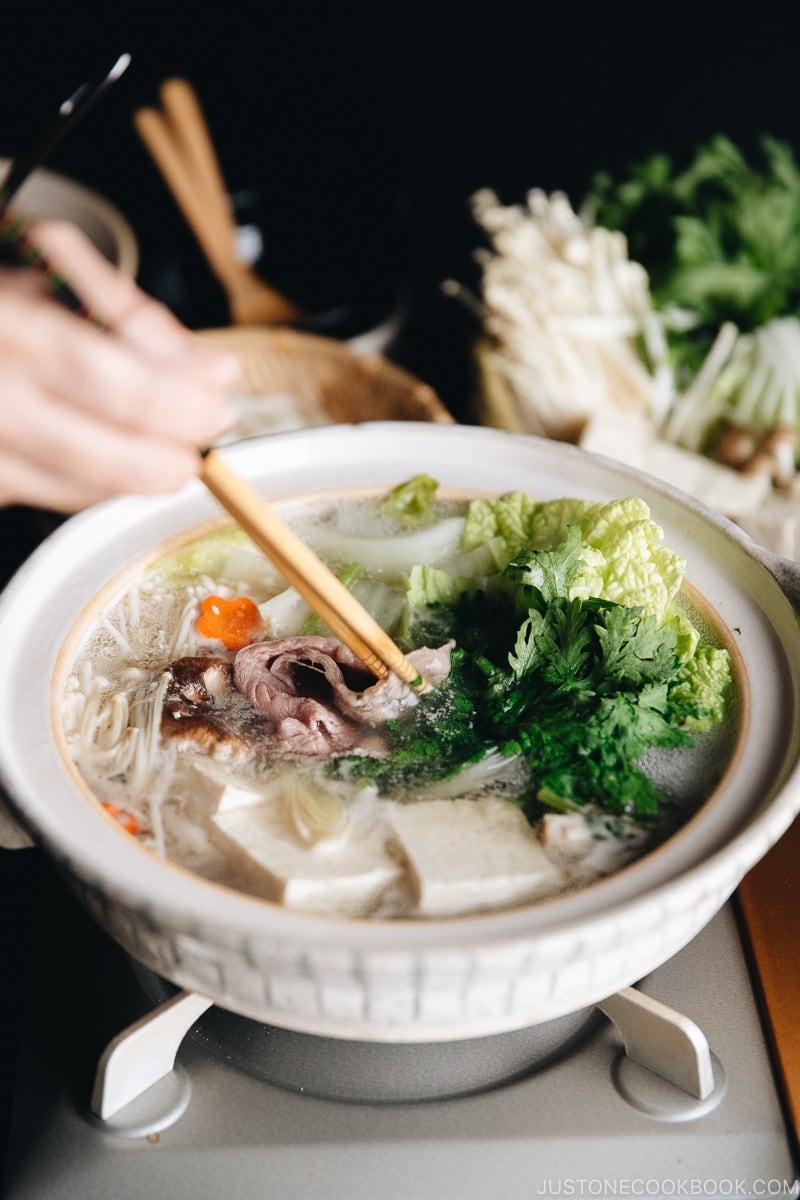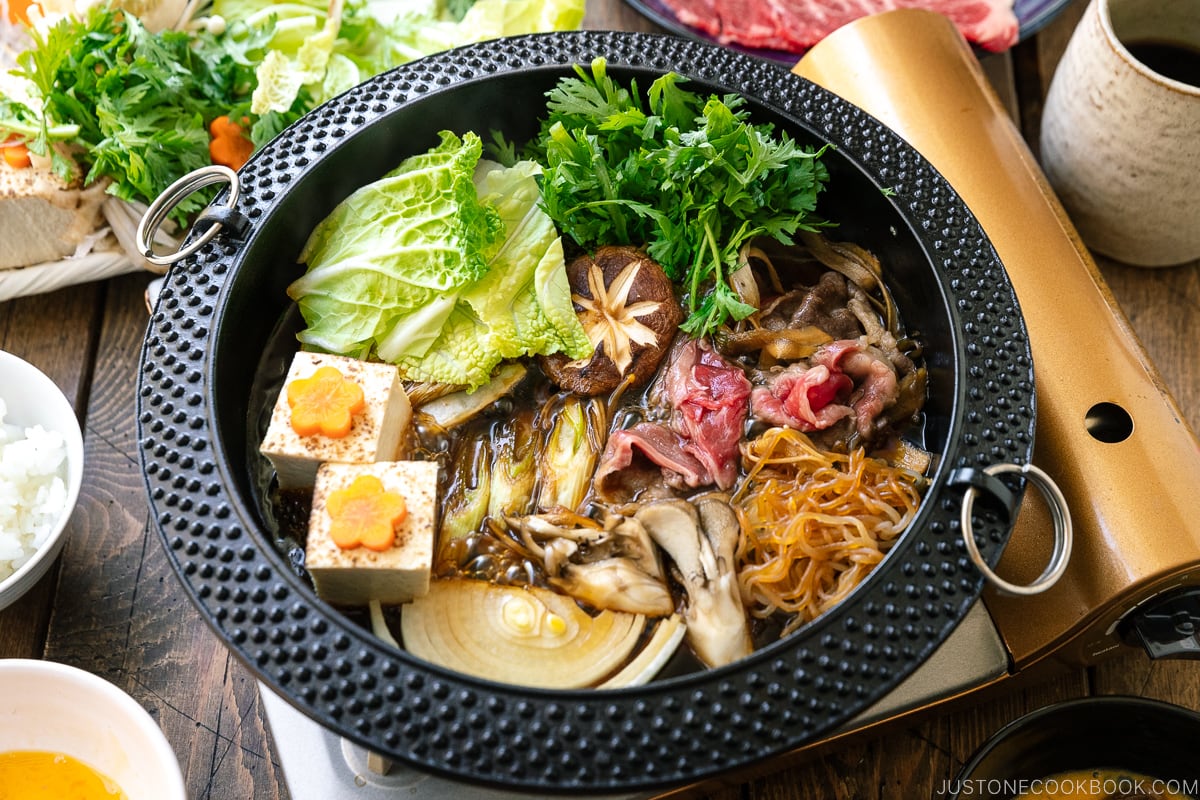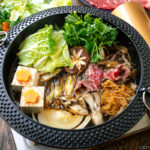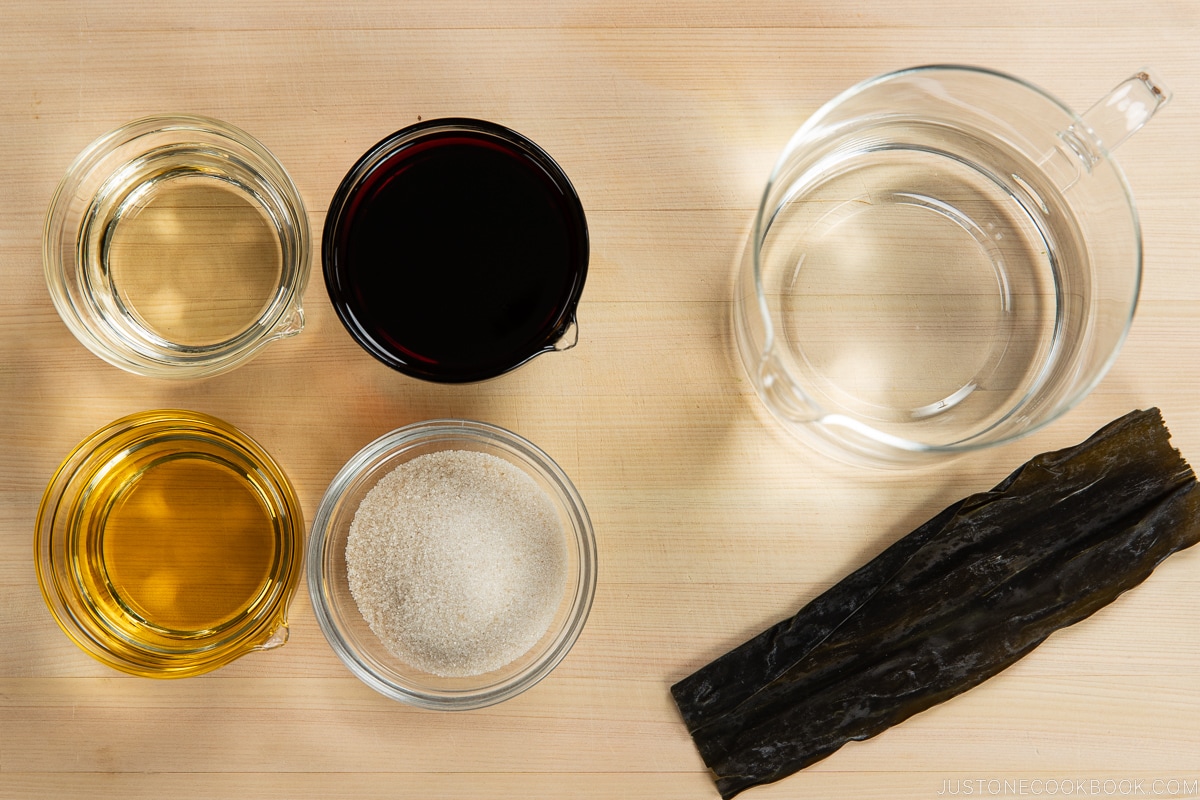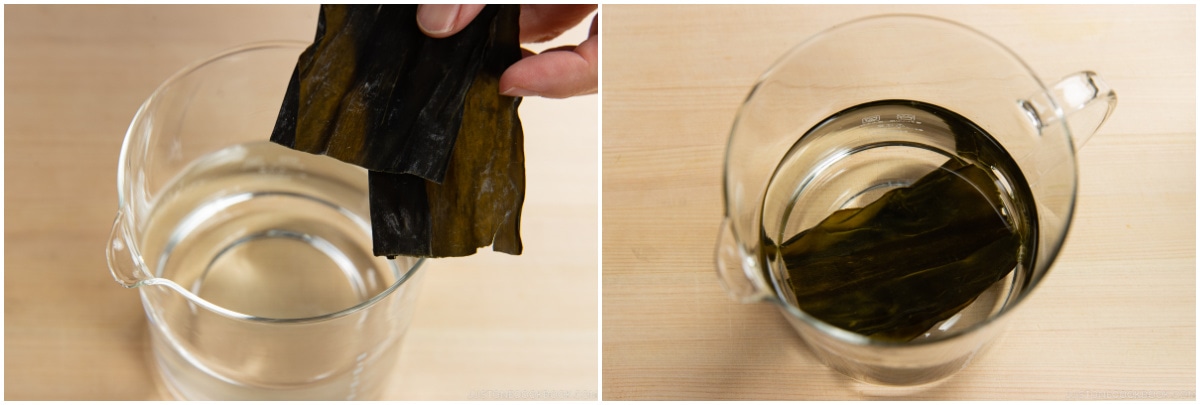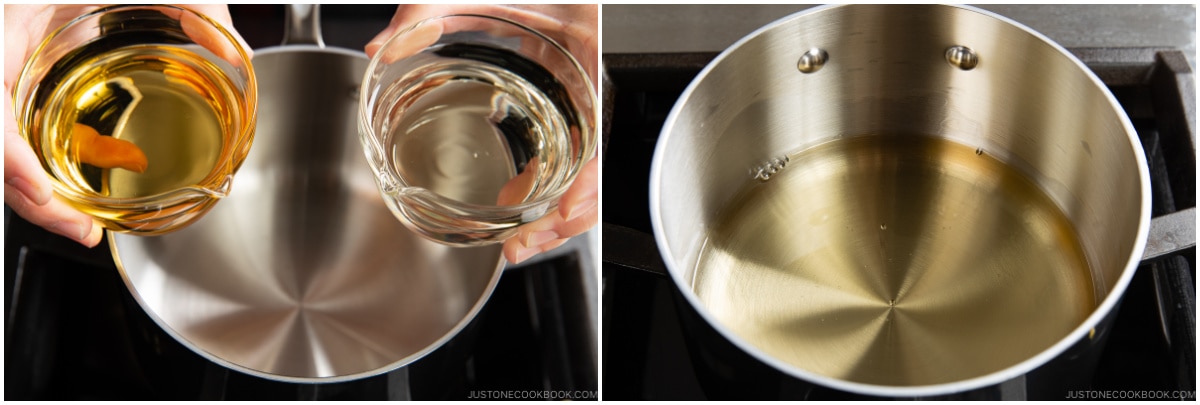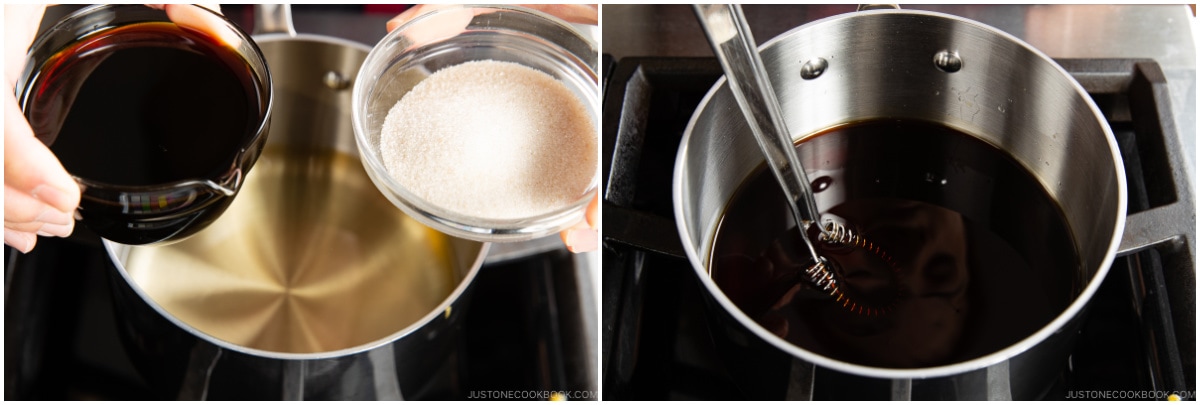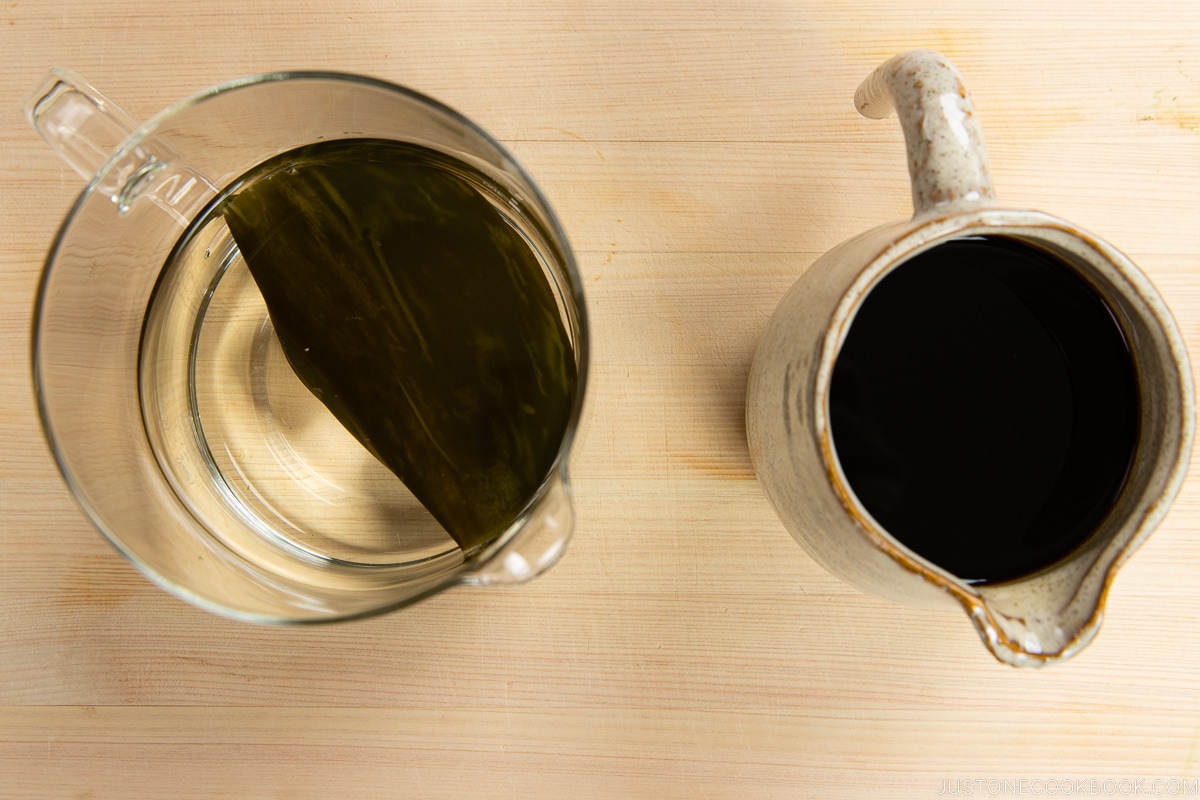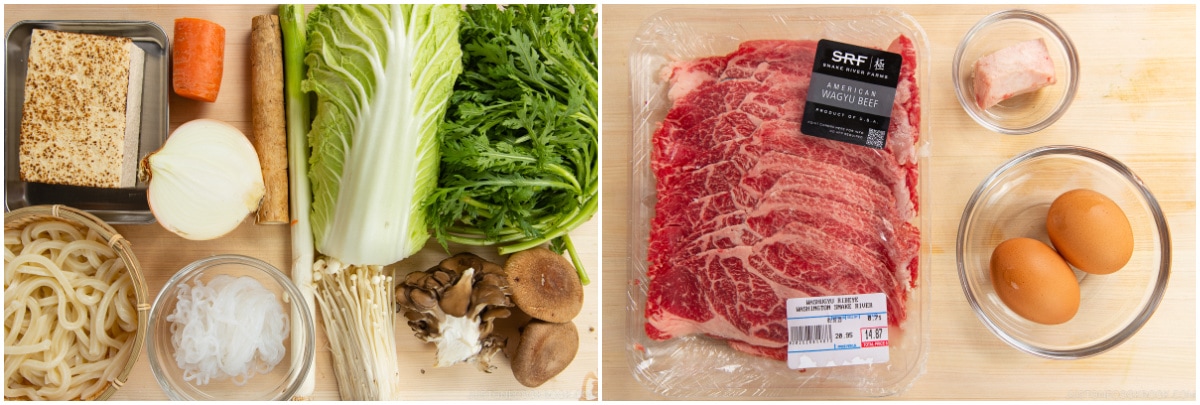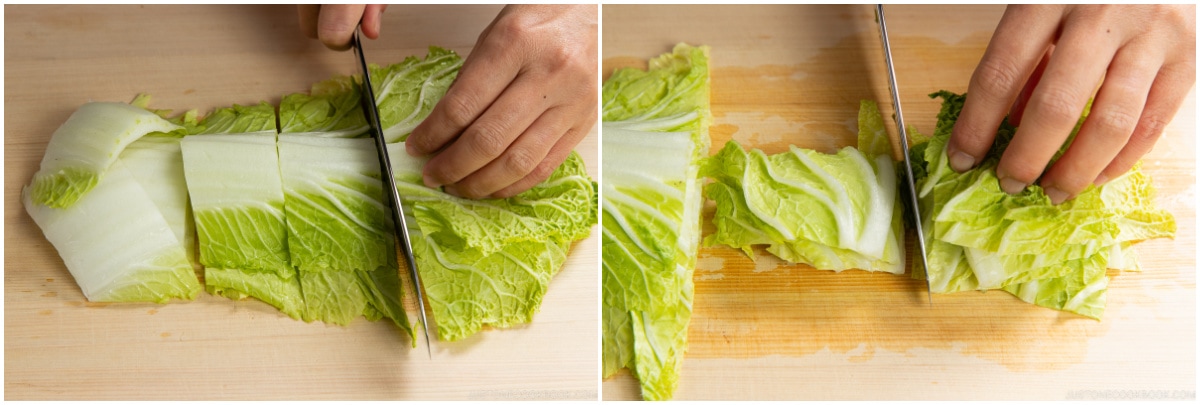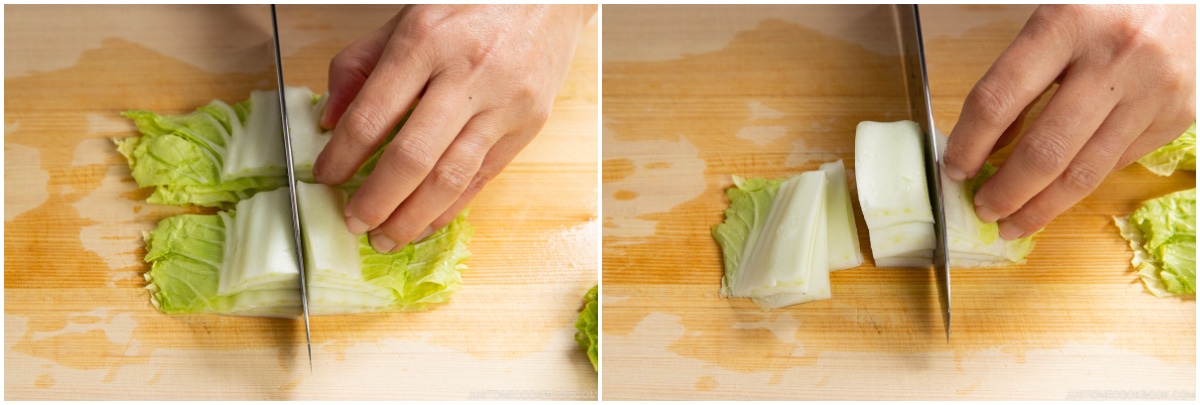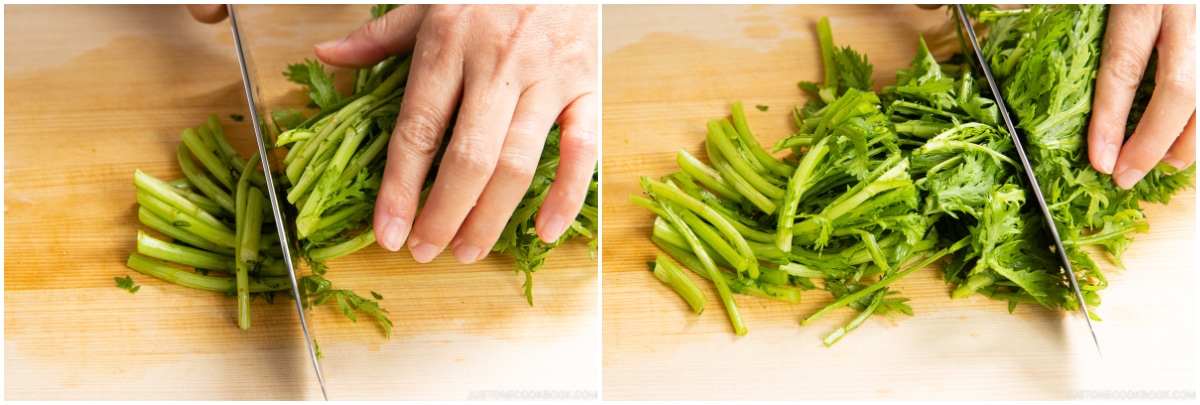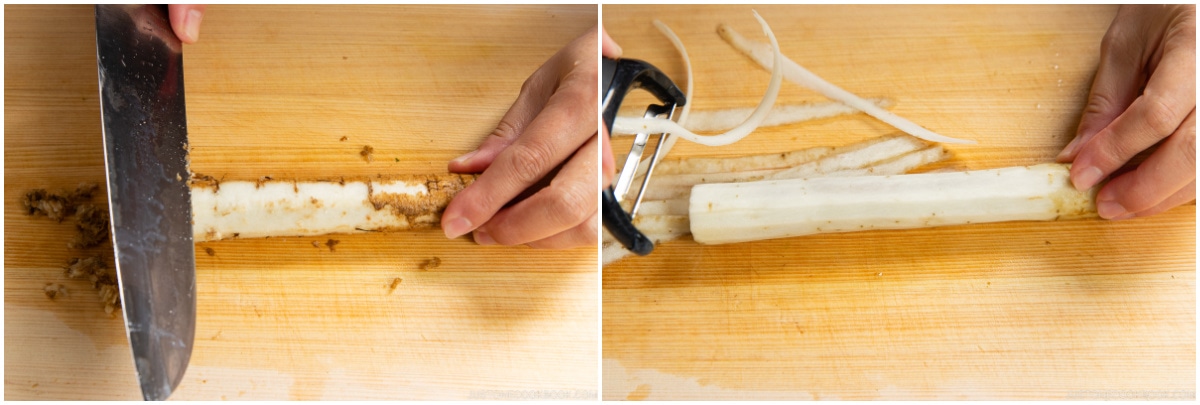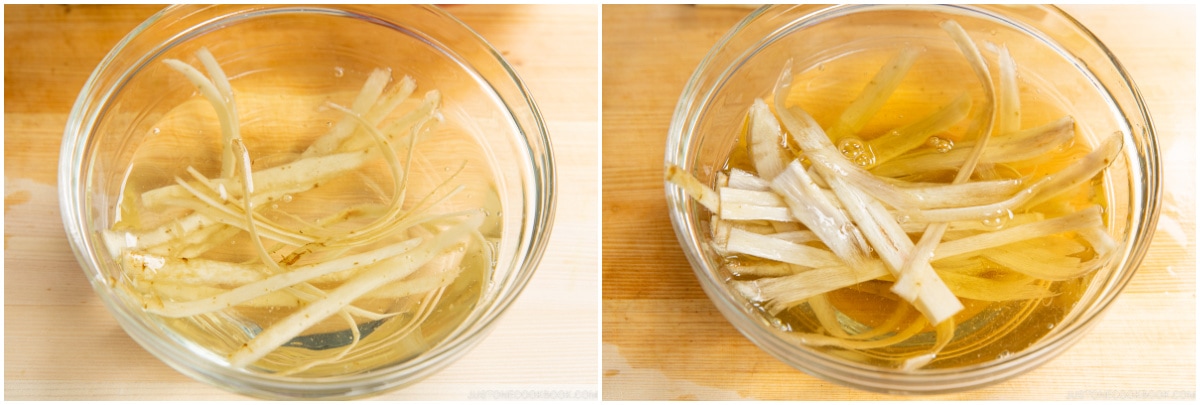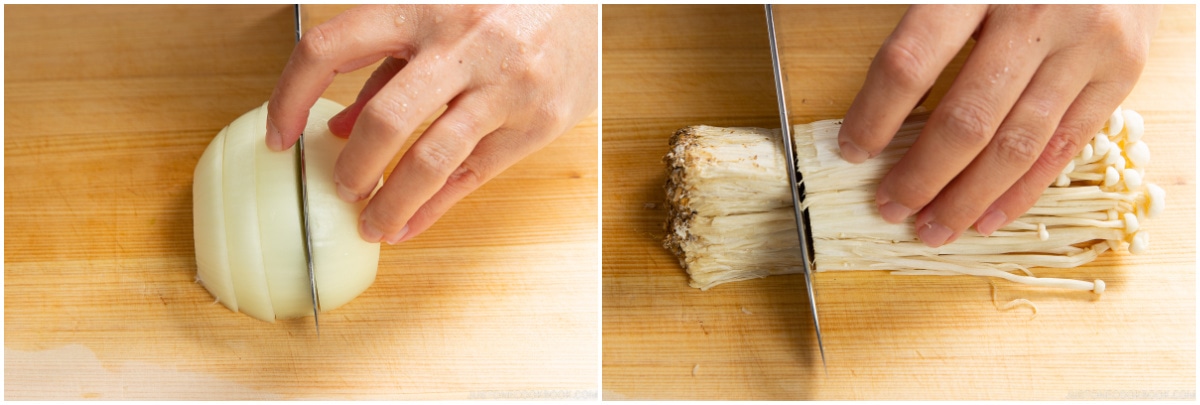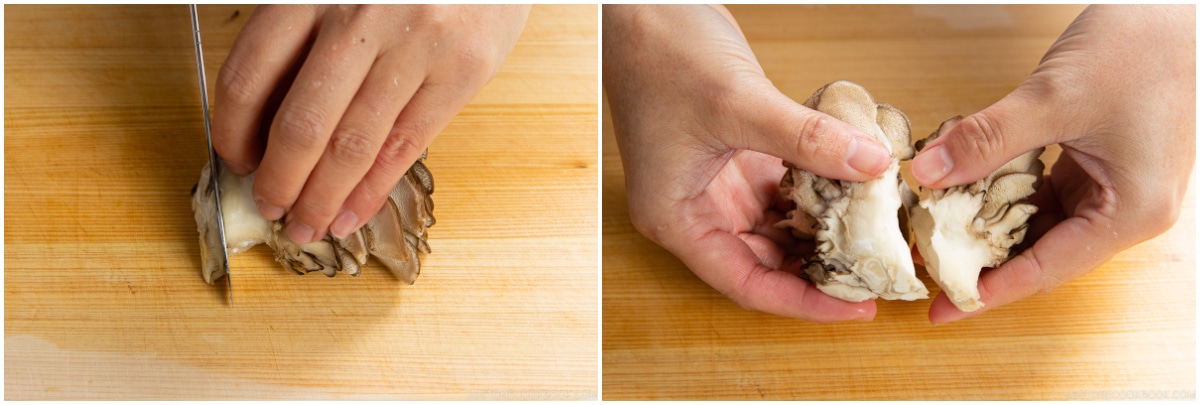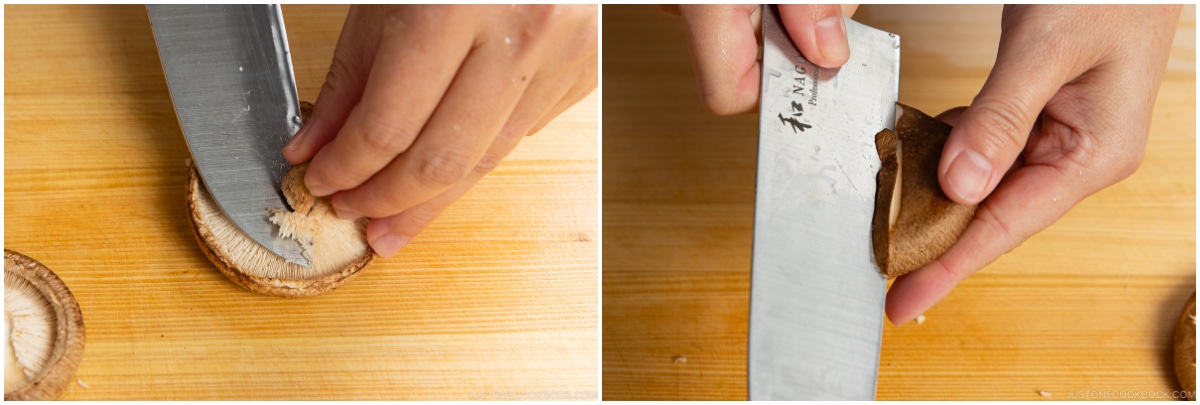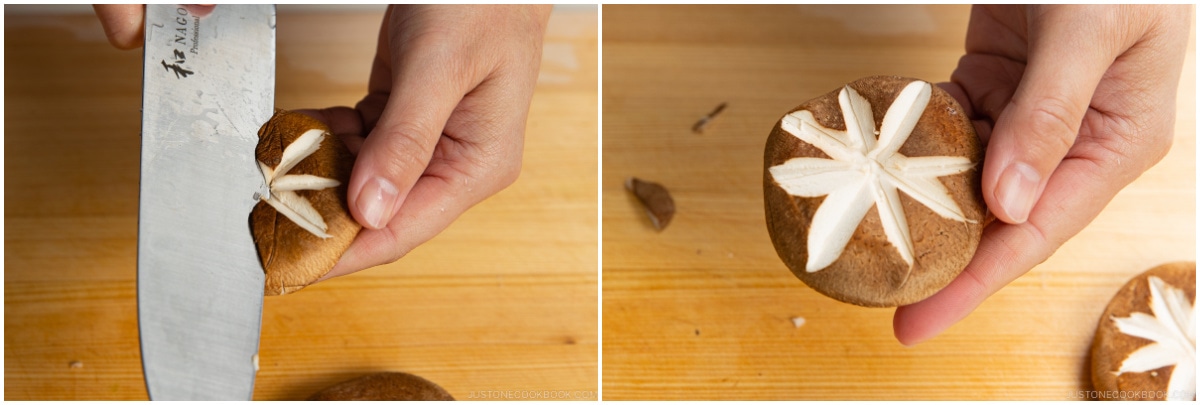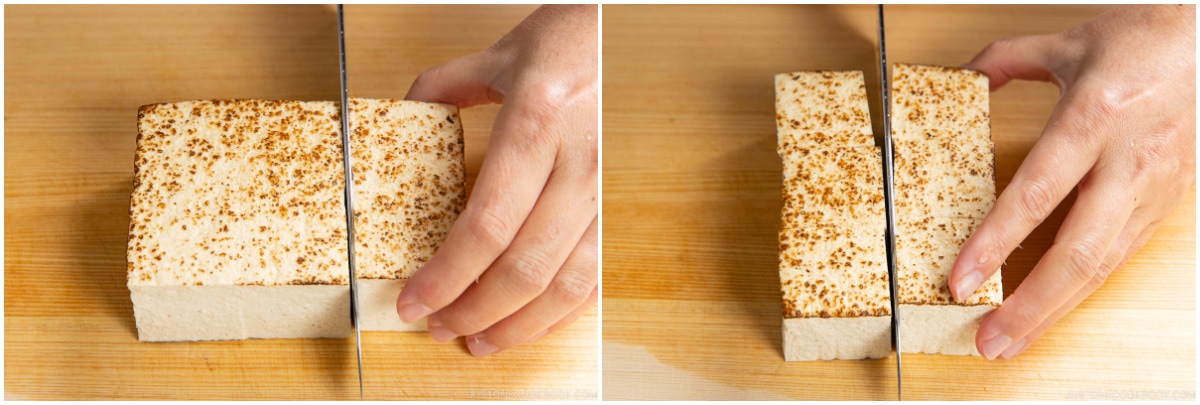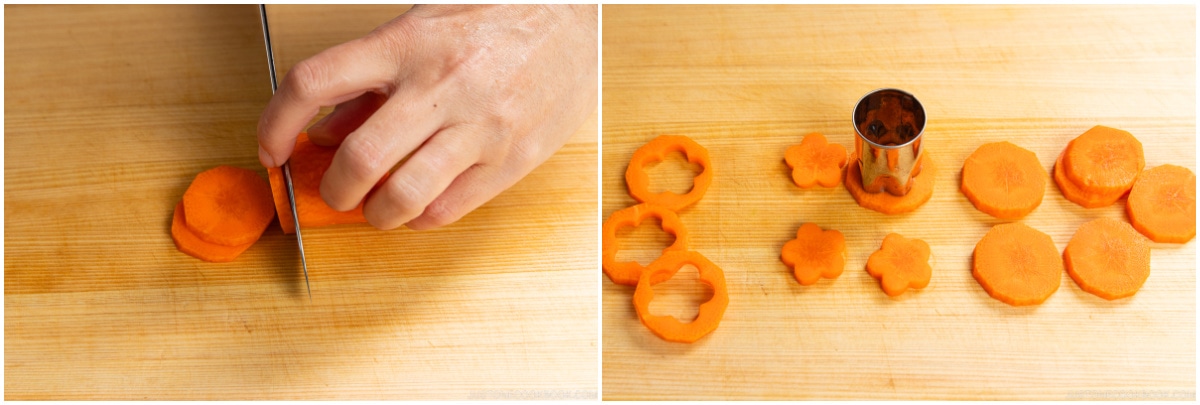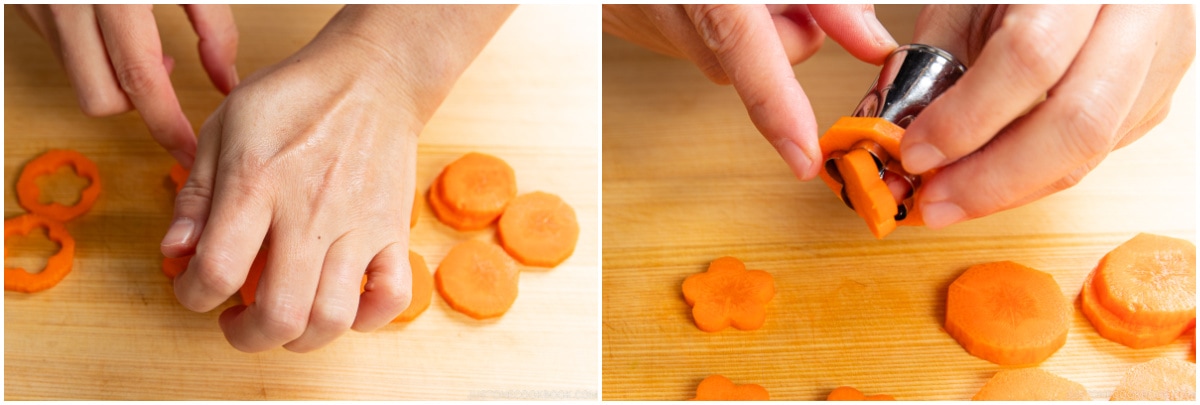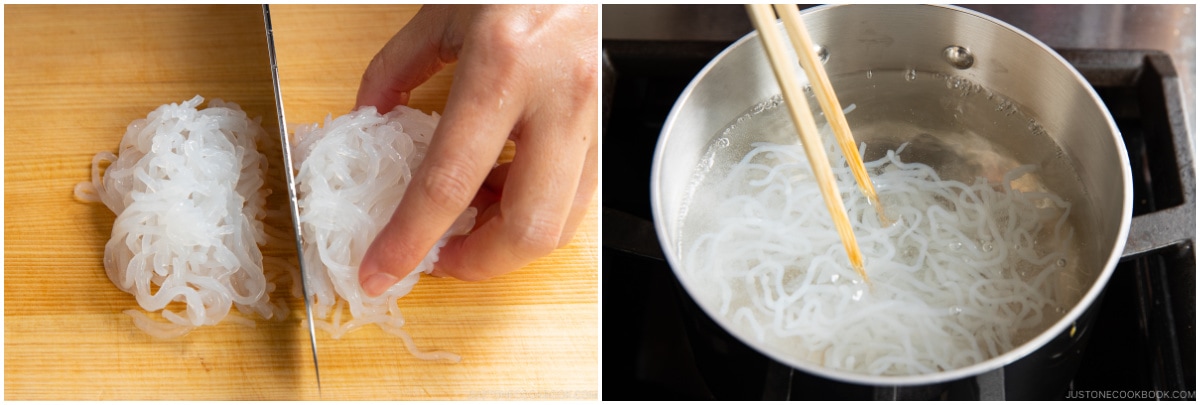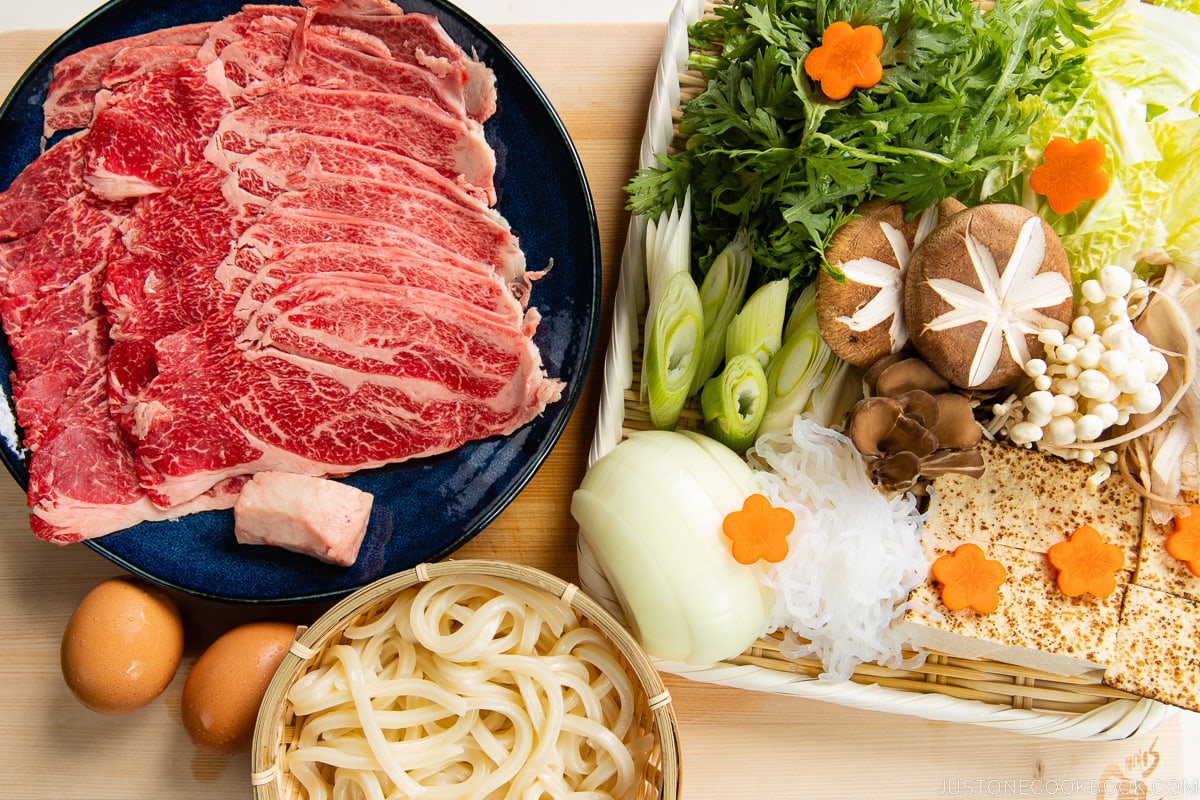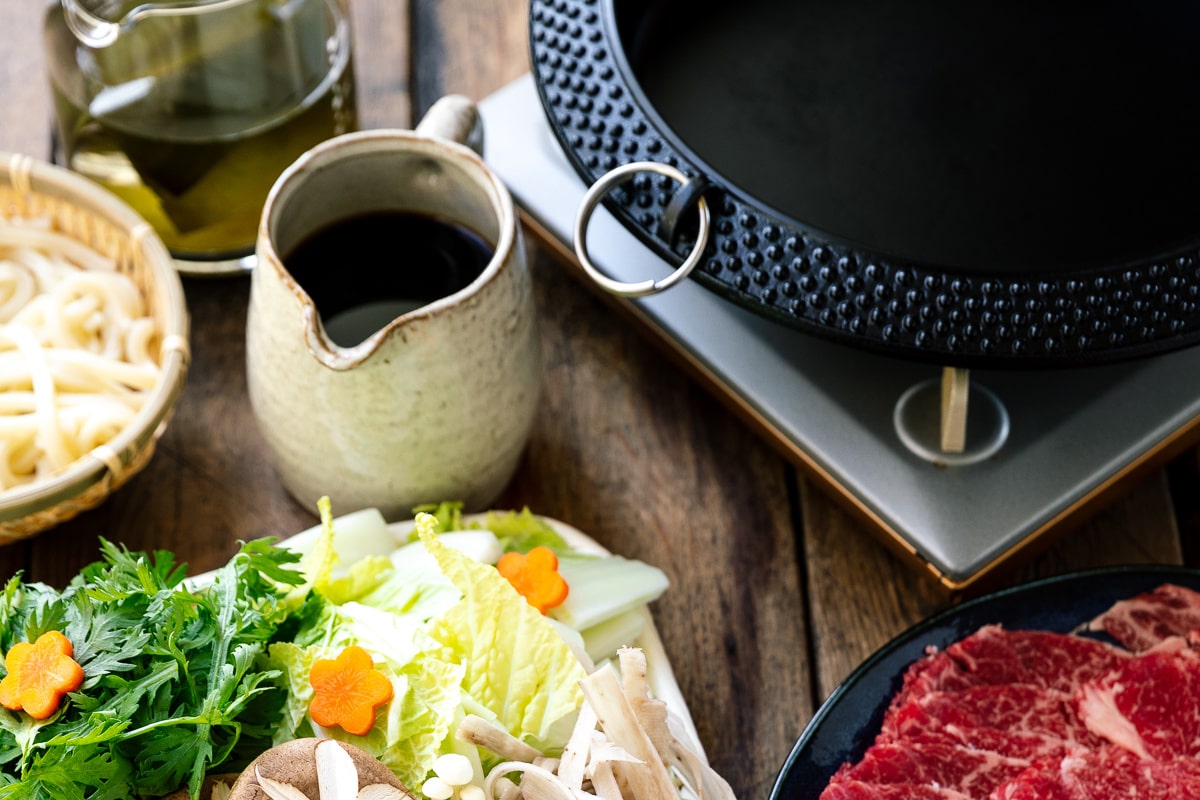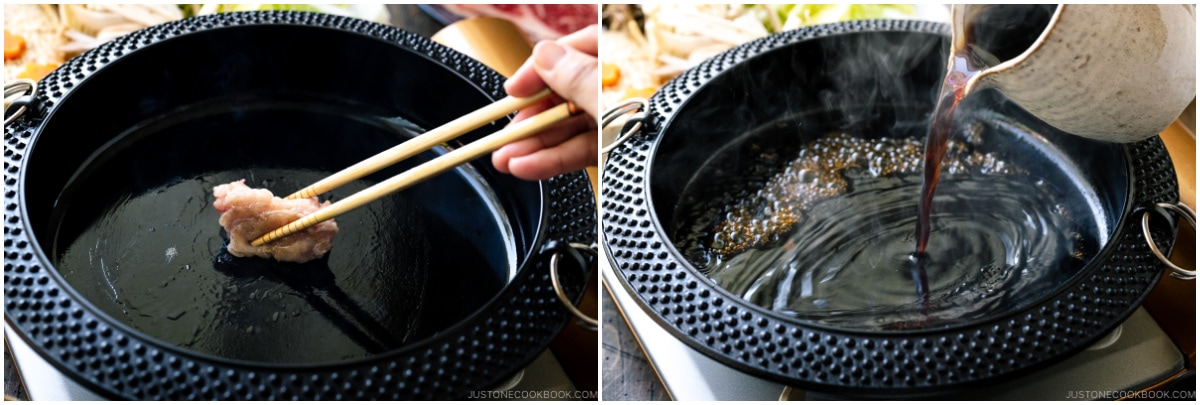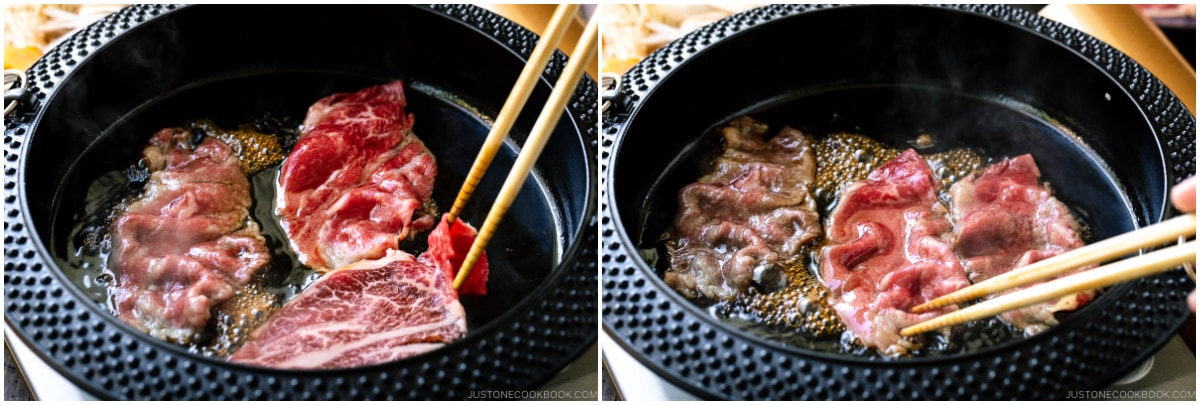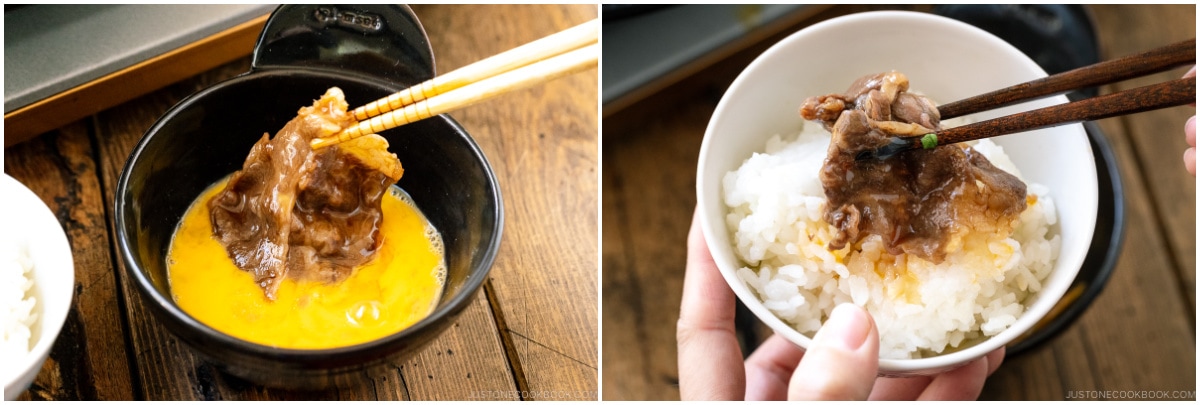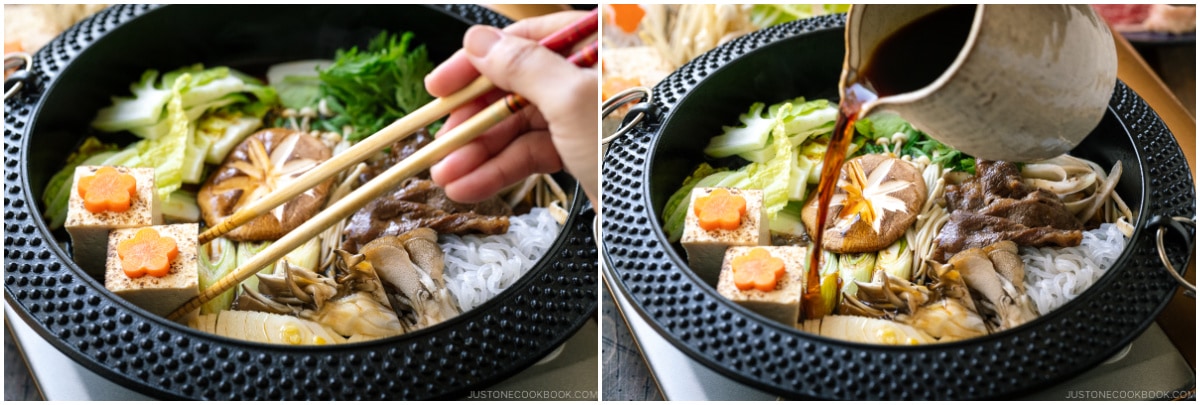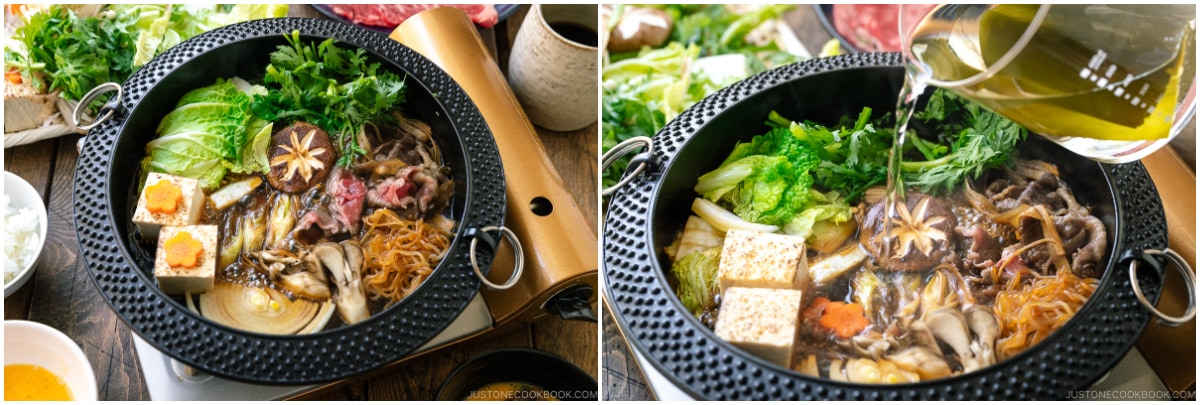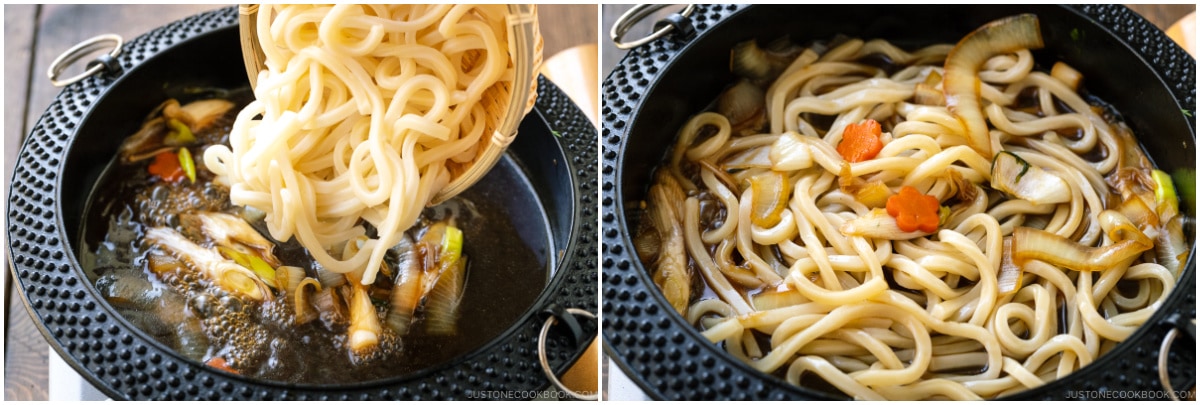The Japanese love cooking nabe hot pots, especially in the cold winter months. While there are many variations, one of the most popular hot pot dishes is Sukiyaki (すき焼き) or Japanese Beef Hot Pot. It’s warm, flavorful, and an easy social meal to share with a close-knit group of family or friends. Today, I want to show you how you can replicate and enjoy sukiyaki at home.
What’s Sukiyaki?
Sukiyaki (すき焼き) is a popular Japanese hot pot dish that we often prepare and serve at the table. We slowly grill or simmer well-marbled beef, alongside vegetables, tofu, and mushrooms in a shallow cast-iron pot. The soup broth is rich and bursting with sweet, salty, and savory flavor. Interestingly, the Kanto region once called their version of sukiyaki gyunabe (牛鍋). Gyunabe’s popularity spread from Yokohama, where many foreigners lived, and then became popular in Tokyo. Gyunabe then influenced the sukiyaki culture in the Kanto region. When the Great Kanto Earthquake happened in 1923, the gyunabe restaurants in the Kanto (Tokyo) region disappeared. During that time, sukiyaki restaurants in the Kansai (Osaka) region expanded into the Kanto region. Since the two dishes were quite similar, people in the Kanto region started to call their original gyunabe ‘sukiyaki.’
Kansai Style vs. Kanto Style Sukiyaki
Did you know that there are two types of sukiyaki? We have the Kanto-style and the Kansai-style and there are some distinctions between them. As my mom’s side of the family is from Osaka (Kansai) and my dad’s side is from Tokyo (Kanto), I grew up eating a mix of Kansai and Kanto foods without realizing it. Both regions enjoy sukiyaki with a beaten egg, but people would cook and enjoy the dish differently.
Kanto-style Sukiyaki
The most noteworthy feature of Kanto-style sukiyaki is the warishita (割り下) or sukiyaki sauce. The sauce is made by boiling soy sauce, sake, mirin, and sugar and diluted with kombu dashi to your liking. It plays an important role in determining the overall taste of the dish (we’ll talk about it later). Also, the Kanto version grills the beef in a cast iron pot. Some people grill the beef directly on the greased pot while others cook the beef with a little bit of the sukiyaki sauce. For my recipe, I used the latter method to avoid marbled beef from getting stuck on the cast-iron pot. After you enjoy a few slices of the beef, you would then simmer the remaining meat and other ingredients in the warishita until tender. This style of cooking is hugely influenced by the original gyunabe.
Kansai-style Sukiyaki
On the other hand, Kansai-style sukiyaki involves grilling each slice of beef in the cast iron pot. When both sides of the meat are about 80% cooked, we would sprinkle plenty of sugar so that it covers the surface of the meat. Then, sprinkle soy sauce to balance out the flavor. After enjoying a few slices of beef, you would then add vegetables such as napa cabbage. It doesn’t use dashi stock so the Kansai-style sukiyaki doesn’t have much moisture and the flavor is slightly stronger. Since the moisture content in vegetables varies depending on the season, the cook needs to adjust the seasoning accordingly in order to achieve the best flavor. Therefore, the skill of the person who makes it greatly influences Kansai-style sukiyaki. This is where the nabe bugyo (hot pot magistrate 鍋奉行)’s skills are shown! In my recipe below, I use the Kanto-style sukiyaki method because it’s a lot easier for beginner cooks to follow.
Well-Marbled Sukiyaki Beef
Unquestionably, beef is the star ingredient for this hot pot, so I recommend using quality meat when making sukiyaki at home. The Japanese like to splurge and enjoy really good quality, well-marbled beef for both sukiyaki and shabu shabu. Wagyu (beef from cows raised in Japan) is very expensive ($40/lb), so typically each person only enjoys about 120-150 grams of sliced meat. Because of the higher fat content in each slice, you don’t really need a lot of it. Japanese grocery stores have packages of thinly sliced “sukiyaki beef.” They also have “shabu shabu beef” but those are thinner than the ones for sukiyaki, so don’t pick the wrong package. We do not want chewy meat for the hot pot. If possible, find a well-marbled piece of meat so that the fat of the meat becomes tender when you eat. If you can’t find pre-sliced beef, you can try slicing the ribeye at your home. Follow my directions and tricks on How To Slice Meat.
Make Your Own Sukiyaki Sauce (Warishita)
The Kanto-style sukiyaki needs warishita (割り下), the sukiyaki sauce. It’s very simple to make with just 4 ingredients: soy sauce, sake, mirin, and sugar. Some recipes already include kombu dashi in the sauce while others don’t. I prefer to keep them separate so that the sukiyaki sauce lasts longer in the refrigerator (water/dashi in the sauce will not keep long). It’s very easy to cook the sauce. Boil the sake and mirin first to let the alcohol evaporate, then add sugar and soy sauce until the sugar is completely dissolved. Make the sukiyaki sauce ahead and store it in an airtight container in the refrigerator for up to a month (or longer!). You can use this sukiyaki sauce for Gyudon (Beef Rice Bowl), Simmered Beef and Tofu (Niku Dofu), Nikujga (Japanese Meat and Potato Stew), simmered fish, and more!
Sukiyaki Ingredients and Substitutions
Besides good quality beef, you will need to prepare a variety of vegetables, a few kinds of mushrooms, grilled tofu (or regular tofu), and shirataki noodles (yam noodles). Typically we use leafy vegetables such as napa cabbage and chrysanthemum greens, onion, Tokyo negi (long green onion), carrot, and gobo (burdock root). You can also use more common vegetables like cabbage, spinach, watercress, eggplant, potatoes, or any other Asian vegetable such as bok choy or bean sprouts. These are not classic sukiyaki ingredients, but they will still taste delicious cooked in the sukiyaki sauce! For vegan/vegetarian, you can use meat alternative products or add more tofu and meaty mushrooms such as king oyster mushrooms.
Cooking Sukiyaki at the Dining Table
We usually cook Sukiyaki in a cast-iron pot over a portable butane stove at the dining table. I recommend getting these items for sukiyaki and other table-top Japanese hot pot dishes.
Cast-iron sukiyaki pot – I got mine from MTC Kitchen (use JOC10 for 10% off!). Iwatani portable butane stove – MTC kitchen sells this and this. Butane Fuel for the portable stove
Can we use a donabe (Japanese clay pot) for sukiyaki? The answer is no. You are not supposed to use high heat for the donabe and it’s not meant for grilling/searing the meat. For the table, each person will need their own set of chopsticks, a medium bowl/plate for the cooked food from the pot, and a small bowl for a beaten egg. Prepare a few sets of communal long cooking chopsticks for cooking the raw meat and vegetables. It’s a fun dinner for family and friends’ get-together, and not to mention, all you have to do is to chop ingredients before dinner time!
Can I Use an Electric Hot Pot?
How to Eat Sukiyaki the “Authentic” Way
I am a bit hesitant to talk about the “authentic” way the Japanese enjoy sukiyaki as some of you may not find it appetizing. However, since some of you may eat sukiyaki in Japan and this is the traditional way to enjoy sukiyaki, so you won’t get caught off guard. Whether you follow this method or not, I think it’s worth discussing it here. In Japan, we enjoy sukiyaki by dipping cooked beef and other ingredients in raw eggs. I know, I can almost hear “eww” from some of my readers but that’s the fact. In the past, eating meat was officially prohibited until the Meiji era in Japan. Ordinary people were not allowed to eat meat until the Meiji emperor started eating beef. So it was said that dipping sukiyaki in cold eggs helps eliminate the smell of beef and to prevent burning your mouth with hot food. Thanks to improvements in meat quality, it is now common to eat delicious beef. Also, dipping it in an egg gives it a deeper flavor, so this way of eating has continued to this day. It’s a custom that we eat sukiyaki with an egg, but some people skip it. If you travel to Japan and try sukiyaki there, I actually highly recommend trying it at least once as eggs there are considered safe to consume raw. The sweetness from raw egg coats well with salty, strong-flavored beef and vegetables and it amazingly balances out the flavors very well. Since raw eggs here in the U.S. are not safe to consume, you can purchase pasteurized eggs. Although I found one at a Japanese market, Nijiya, before, it’s not always there and pasteurized eggs are hard to find elsewhere. If you have an immersion circulator (sous vide precision cooker), you can pasteurize your eggs at home using the sous-vide method.
Sukiyaki vs. Shabu Shabu
Now that you’re familiar with sukiyaki, you may wonder what is the difference between sukiyaki and another popular hot pot dish, shabu shabu. Let’s take a closer look.
Sukiyaki (すき焼き)
We sear thinly sliced beef and then cooked it alongside other ingredients in a sweet and salty soy sauce-based sauce. It is full of bold flavors straight from the pot. Traditionally, we enjoy all the cooked food after dipping in a beaten raw egg.
Equipment: Cast-iron pot Broth: Warishita (a mixture of soy sauce, sake, mirin, and sugar, diluted with kombu dashi) Meat: Well-marbled beef (thicker than shabu shabu beef) Vegetables: Napa cabbage, chrysanthemum greens, Tokyo negi, carrot, shirataki noodles Tofu: Grilled tofu Mushrooms: Shiitake, enoki, shimeji, maitake Final course (Shime): Udon noodles Dipping sauce: Raw eggs
Shabu Shabu (しゃぶしゃぶ) [recipe]
In this dish, we cook thinly sliced beef or pork and all kinds of ingredients in a clear kombu-based broth. The flavor is subtle and you dip the cooked food in a ponzu or sesame-based sauce.
Equipment: Donabe (Japanese clay pot) Broth: Kombu dashi Meat: Well-marbled beef or pork Vegetables: Napa cabbage, chrysanthemum greens, Tokyo negi, mizuna, carrot Tofu: Medium-firm tofu Mushrooms: Shiitake, enoki, shimeji, maitake Final course (Shime): Udon noodles, rice Dipping Sauce: Ponzu sauce and/or sesame sauce
Despite having different flavors and cooking pots, both sukiyaki and shabu shabu have similar ingredients, such as leafy vegetables, tofu, mushrooms, and so on. Both sukiyaki and shabu shabu are representative dishes of Japan that eventually spread throughout the country and around the world. With high-prized beef on the table, it is always a delicacy in Japan. People of all ages, from children to adults, love it!
Other Hot Pot Recipes
Shabu Shabu Yosenabe Mizutaki (Chicken Hot Pot) Chanko Nabe (Sumo Stew) Soy Milk Hot Pot Nabemonot: A Guide to Japanese Hot Pot
Wish to learn more about Japanese cooking? Sign up for our free newsletter to receive cooking tips & recipe updates! And stay in touch with me on Facebook, Pinterest, YouTube, and Instagram. Editor’s Note: This post was originally published on February 11, 2015. It’s been republished on January 29, 2023, with new images, blog content, and a revised recipe.
